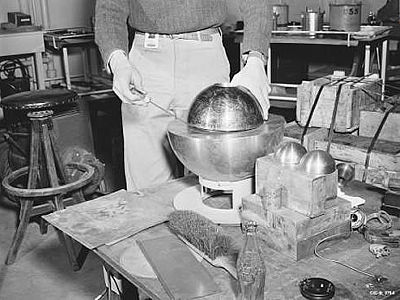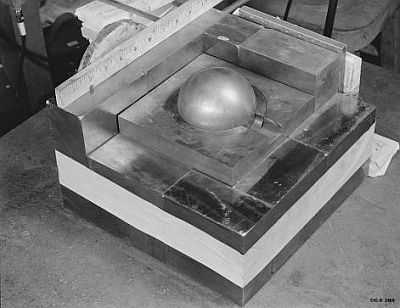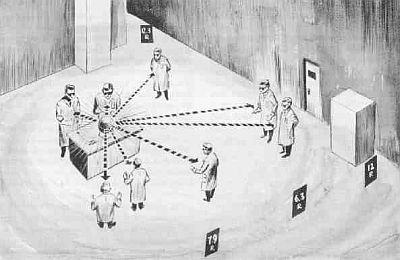A subcritical mass of plutonium 'Demon Core'

'There are tens of thousands of people around the world, such as a madness that can be catastrophic just by slipping a little, or an object that scientists knead with their bare hands can put the world in fear of death in a few months. I don't like the person who wrote this article, such as the mad scientist who doesn't think that he or she may die in the world, or the naming of 'Demon Core'. ' The item ' Demon Core ' that appeared in the Japanese version of Wikipedia at the end of last month is quite excellent.
As the name suggests, various episodes are flying to the extent that it fits the name 'Demon Core', and there are also reproduction photos, so you can feel the horror of the experiment contents.
The contents are from the following.
Demon Core-Wikipedia
First of all, the whole explanation. This alone gives a fairly destructive overview.
Demon core is an uncritical mass of about 14 pounds (6.2 kg) that was used in various experiments at the Los Alamos National Laboratory in the United States and was later incorporated into an atomic bomb and used in crossroad operations. Plutonium mass. It was nicknamed the 'Demon Core' because it caused criticality accidents in 1945 and 1946, respectively, due to careless handling and killed two scientists.
So, first of all, from the first event. By the way, it has long been known that nuclear power plants are often deceived by calling them 'events' rather than 'accidents' even if an accident occurs because it gives the impression that there is a safety problem. I am.
On August 21, 1945, physicist Harry Daghlian, who worked at the Los Alamos National Laboratory, was experimenting with neutron reflectors using a mass of plutonium, later called a demon core. The experiment was based on the idea that blocks of tungsten carbide, which is a neutron reflector, were stacked around a plutonium mass to gradually bring it closer to criticality. If the block is brought too close to the core, the criticality will start immediately and a large amount of neutron rays will be emitted, which is dangerous. However, Darian slipped and accidentally dropped the block onto a plutonium block. The plutonium mass quickly reached criticality, and the neutrons emitted from it hit Darian directly. Darian hurriedly moved the block over the plutonium mass, but he was already exposed to a lethal dose of radiation (5.1 Sv). Darian died 25 days later due to acute radiation injury.
This is this reproduction photo.

I'm not sure what the 'event' is, but since there were no casualties other than this researcher, it may be at the event level. However, the next 'second event' makes this plutonium mass worthy of the name 'demon core.'
On May 21, 1946, Canadian physicist Louis Slotin and colleagues at the Los Alamos National Laboratory accurately determine how close a neutron reflector is to a subcritical fissile material to reach criticality. I was conducting an experiment to check the position. The neutron reflector used this time is beryllium, and the one used as a subcritical fissile material is the demon core that killed Darian last year. Slotin et al. Prepared two hemispherical pieces of beryllium in the shape of a sphere, and installed a demon core in the center. Then, insert a flat-blade screwdriver between the upper and lower halves of the beryllium hemisphere, and shake the flat-blade screwdriver in your hand to move the upper half hemisphere closer to and away from the core, and use the scintillation detector relative to it. We conducted an experiment to measure specific activity. If the pinched driver comes off and the two hemispheres are completely attached, the demon core will quickly reach criticality and emit a large amount of neutron rays, which is dangerous. The experiment was criticized by Los Alamos researcher Richard Feynman as 'tickling the dragon's tail' because of the danger that even a single small mistake could not be tolerated. Although it was a notorious experiment that most researchers refused to participate in, Feynman, a young and illustrious scientist, took the lead in several experiments of this kind. It is said that Enrico Fermi, a Nobel Prize-winning physicist at Los Alamos, also advised that he would die within the year in such a condition.

Of course, 'events' occur ...
Finally, on this day, Slotin's hand slipped, the pinched driver came off, and the two hemispheres were completely stuck together. Immediately, a blue light was emitted from the demon core, and a heat wave pierced Slotin's body. Slotin, noticing that the core had reached a criticality and emitted a large amount of neutrons, hurriedly knocked off the upper half of the hemisphere, stopping the chain reaction and trying to save the lives of other researchers. He was literally at the forefront of the experiment, so he was exposed to a large amount of radiation in a way that blocked the radiation to other researchers. He was exposed to lethal doses (21 Sv) of neutrons and gamma rays in just one second and died nine days later due to radiation damage.
A colleague, Alvin Graves, who was close to Slotin, was also hit by a neutron beam, but he was looking at the demon core over Slotin's shoulder, so the neutron beam was somewhat blocked by Slotin's body for several weeks. I was able to be discharged safely after being hospitalized. However, the absorbed dose was not small, and the sequelae of chronic neuropathy and visual impairment remained, and he died of a heart attack 20 years later after suffering from radiation injury for a lifetime.
Fortunately, the other researchers were safe with no physical impact, as they were far enough away from the criticality demon core.

'Immediately' of 'not immediately affecting health' that was frequently mentioned at this Fukushima Daiichi nuclear power plant-related conference means 'I don't die right now, but I may die soon. , Where the threshold is depends on the person, and there is no way to track it. ”However, this demon core is at the level of“ immediate health effects ”. Perhaps unless this level of 'event' occurs, it will not 'immediately affect health' ...
Related Posts:
in Science, Posted by darkhorse







